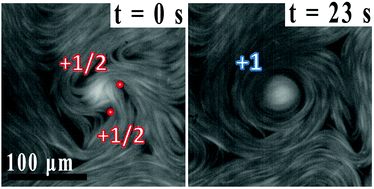Driven topological transitions in active nematic films†
Abstract
The topological properties of many materials are central to their behavior. In intrinsically out-of-equilibrium active materials, the dynamics of topological defects can be particularly important. In this paper, local manipulation of the order, dynamics, and topological properties of microtubule-based active nematic films is demonstrated in a joint experimental and simulation study. Hydrodynamic stresses created by magnetically actuated rotation of disk-shaped colloids in proximity to the films compete with internal stresses in the active nematic, influencing the local motion of +1/2 charge topological defects that are intrinsic to the nematic order in the spontaneously turbulent active films. Sufficiently large applied stresses drive the formation of +1 charge topological vortices through the merger of two +1/2 defects. The directed motion of the defects is accompanied by ordering of the vorticity and velocity of the active flows within the film that is qualitatively unlike the response of passive viscous films. Many features of the film's response to the stress are captured by lattice Boltzmann simulations, providing insight into the anomalous viscoelastic nature of the active nematic. The topological vortex formation is accompanied by a rheological instability in the film that leads to significant increase in the flow velocities. Comparison of the velocity profile in vicinity of the vortex with fluid-dynamics calculations provides an estimate of the film viscosity.



 Please wait while we load your content...
Please wait while we load your content...
